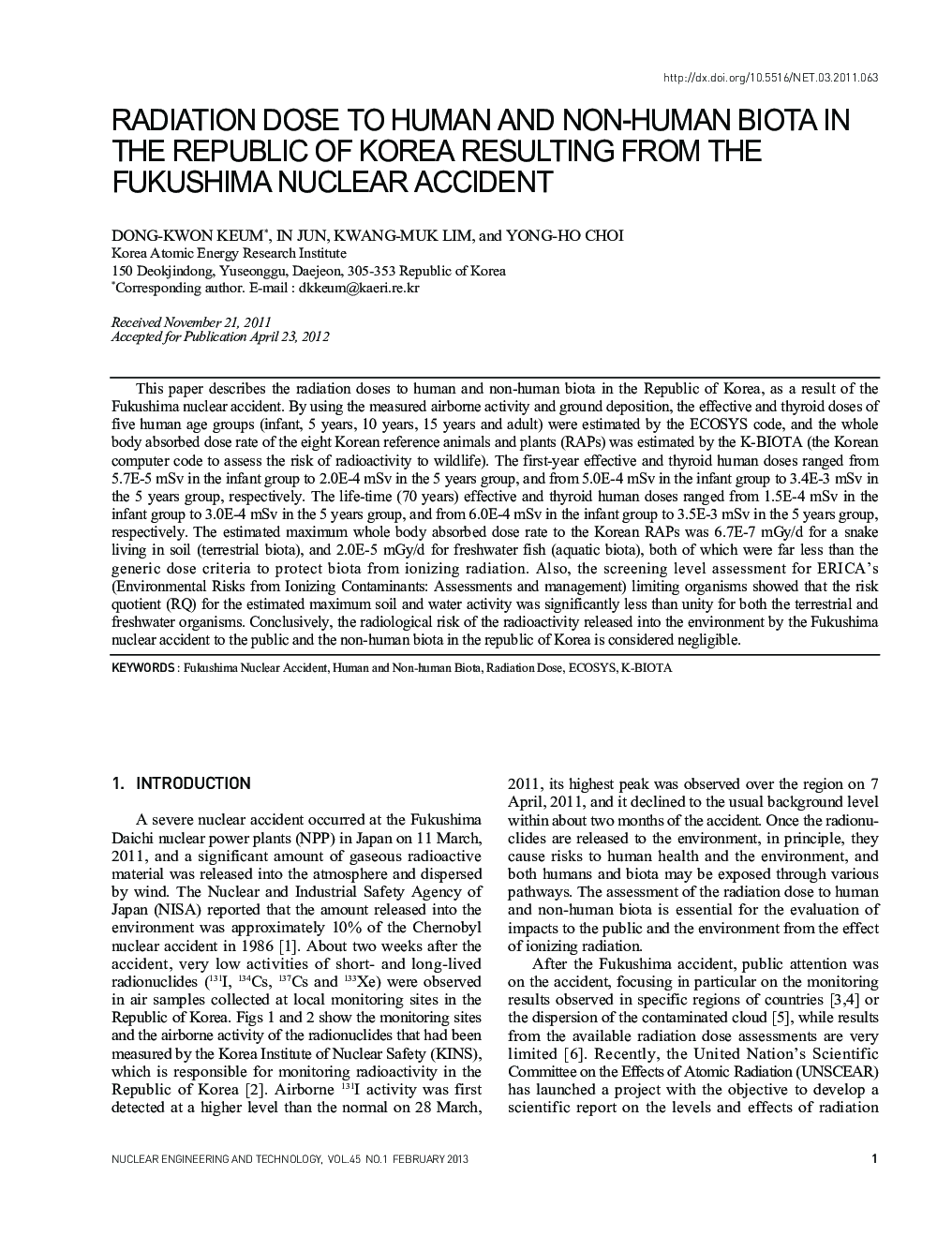| کد مقاله | کد نشریه | سال انتشار | مقاله انگلیسی | نسخه تمام متن |
|---|---|---|---|---|
| 1740247 | 1017333 | 2013 | 12 صفحه PDF | دانلود رایگان |
عنوان انگلیسی مقاله ISI
RADIATION DOSE TO HUMAN AND NON-HUMAN BIOTA IN THE REPUBLIC OF KOREA RESULTING FROM THE FUKUSHIMA NUCLEAR ACCIDENT
دانلود مقاله + سفارش ترجمه
دانلود مقاله ISI انگلیسی
رایگان برای ایرانیان
کلمات کلیدی
موضوعات مرتبط
مهندسی و علوم پایه
مهندسی انرژی
انرژی هسته ای و مهندسی
پیش نمایش صفحه اول مقاله

چکیده انگلیسی
This paper describes the radiation doses to human and non-human biota in the Republic of Korea, as a result of the Fukushima nuclear accident. By using the measured airborne activity and ground deposition, the effective and thyroid doses of five human age groups (infant, 5 years, 10 years, 15 years and adult) were estimated by the ECOSYS code, and the whole body absorbed dose rate of the eight Korean reference animals and plants (RAPs) was estimated by the K-BIOTA (the Korean computer code to assess the risk of radioactivity to wildlife). The first-year effective and thyroid human doses ranged from 5.7E-5 mSv in the infant group to 2.0E-4 mSv in the 5 years group, and from 5.0E-4 mSv in the infant group to 3.4E-3 mSv in the 5 years group, respectively. The life-time (70 years) effective and thyroid human doses ranged from 1.5E-4 mSv in the infant group to 3.0E-4 mSv in the 5 years group, and from 6.0E-4 mSv in the infant group to 3.5E-3 mSv in the 5 years group, respectively. The estimated maximum whole body absorbed dose rate to the Korean RAPs was 6.7E-7 mGy/d for a snake living in soil (terrestrial biota), and 2.0E-5 mGy/d for freshwater fish (aquatic biota), both of which were far less than the generic dose criteria to protect biota from ionizing radiation. Also, the screening level assessment for ERICA's (Environmental Risks from Ionizing Contaminants: Assessments and management) limiting organisms showed that the risk quotient (RQ) for the estimated maximum soil and water activity was significantly less than unity for both the terrestrial and freshwater organisms. Conclusively, the radiological risk of the radioactivity released into the environment by the Fukushima nuclear accident to the public and the non-human biota in the republic of Korea is considered negligible.
ناشر
Database: Elsevier - ScienceDirect (ساینس دایرکت)
Journal: Nuclear Engineering and Technology - Volume 45, Issue 1, February 2013, Pages 1-12
Journal: Nuclear Engineering and Technology - Volume 45, Issue 1, February 2013, Pages 1-12
نویسندگان
DONG-KWON KEUM, IN JUN, KWANG-MUK LIM, YONG-HO CHOI,